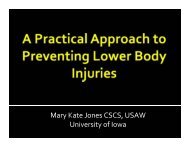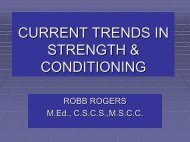The Things that I've Learned and Changed - sbc
The Things that I've Learned and Changed - sbc
The Things that I've Learned and Changed - sbc
Create successful ePaper yourself
Turn your PDF publications into a flip-book with our unique Google optimized e-Paper software.
<strong>The</strong> <strong>Things</strong> <strong>that</strong> I’ve<br />
<strong>Learned</strong> <strong>and</strong> <strong>Changed</strong><br />
Brijesh Patel, MA, CSCS
Why this topic?<br />
• Inspired<br />
• CHANGE IS GOOD<br />
• WHO MOVED MY CHEESE<br />
by Dr. Spencer Johnson
CHANGE<br />
• <strong>Things</strong> change. Every moment is different from the last one. Do things t<br />
change for the better or for the worse? That depends. That depends ds entirely<br />
on you. Change is neutral. It is neither good nor bad. It is simply necessary. If<br />
things did not change, nothing would ever happen.<br />
Change is the way you get from one point to another. It is fundamental to life<br />
itself. Think of all the processes of change going on right now in your body,<br />
which serve to keep you alive from moment to moment.<br />
When things are going along great, something will change. When you're y<br />
full<br />
of despair, something will change. It is the nature of your existence.<br />
Change is the way things happen. Change does not have to stop you u or limit<br />
you. In fact, change will empower you <strong>and</strong> pull you forward if you u let it. You<br />
cannot stop change. And you must not allow it to stop you.<br />
<strong>The</strong> changes keep coming. Through them, you can learn, grow <strong>and</strong> prosper. p<br />
Look for the positive possibilities in every change. <strong>The</strong>y're there, <strong>and</strong> they'll<br />
take you where you want to go.<br />
-Ralph<br />
Marston (www.dailymotivator.com)
#1 Make Sure Your Programs Have<br />
Structural Balance<br />
• Our #1 goal should be to reduce injuries<br />
• Squat/Bend<br />
• Horizontal Push/Pull<br />
• Vertical Push/Pull
#2 Do More Horizontal Pulling<br />
Correctly!<br />
• Only circumstance where balance can get<br />
thrown out the window<br />
• Shoulder blades should move down <strong>and</strong> back<br />
• Don’t just pull….watch the shoulders<br />
• Spread your Chest
Bad Seated Row vs. Good Seated Row
#3 Teach Proper Posture<br />
• Nobody is going to have perfect posture, but we need<br />
to strive to be perfect<br />
• Lifting posture is VITAL…they are under load<br />
• Head/Shoulders/Feet/Thumbs<br />
• Set an Alarm – Cressey
#4 No More Shrugs<br />
• Upper Trap Dominance<br />
• Weak <strong>and</strong> Inhibited<br />
Lower Traps<br />
• Watch Compensations<br />
• Retraction/Protraction/<br />
Depression
#5 Make Sure Push-Ups are in<br />
your Programs<br />
• Closed-chain Upper body exercise<br />
• Shoulder <strong>and</strong> Trunk Stability<br />
• Extremely under-rated<br />
rated
#6 Activation Work<br />
• Activate weak/inhibited muscles prior to<br />
training<br />
• Glute Max<br />
• Glute Medius<br />
• Hip External Rotators<br />
• Psoas<br />
• Scap Retractors <strong>and</strong> Depressors
#7 Tell Your Loved One’s That You<br />
Love <strong>The</strong>m<br />
• Life isn’t only about training<br />
• Tell your parents, spouses, kids, how you feel<br />
• Enjoy what life has to offer
#8 Add Integration Work<br />
• Get inhibited muscles going in “Functional”<br />
positions<br />
• Specific<br />
• Think Gary Gray - triplanar
#9 Get Warm Before you Get Loose<br />
• Summer group<br />
• Get Hot<br />
• Warm-up then loosen-up<br />
• That old jog around the track may not be such a<br />
bad idea<br />
• More Mobility<br />
• Carl Valle’s Article<br />
http://www.elitefts.com/documents/warmup2.pdf
#10 Foam Roll<br />
• Improve Tissue Quality<br />
• Massage <strong>that</strong> everybody can afford<br />
• Gentilcore’s: : Soft Tissue Work for Tough Guys
#11 What to do with Old Foam<br />
Rollers<br />
• Cut in half to use for bridging/adductor work<br />
• Cut length wise to use as lumbar support<br />
Great for 1 Leg Lower, Dead Bugs,<br />
Stretching
#12 Train Core Stability<br />
• Brace <strong>and</strong> Bridge – Stuart McGill<br />
• Progress slower<br />
• Neuromuscular Activation Technique DVD<br />
• "<strong>The</strong> most important aspect of abdominal muscle performance is<br />
obtaining the control <strong>that</strong> is necessary to:<br />
(1) appropriately stabilize the spine,<br />
(2) maintain optimal alignment <strong>and</strong> movement relationships between<br />
the pelvis <strong>and</strong> spine, <strong>and</strong><br />
(3) prevent excessive stress <strong>and</strong> compensatory motions of the pelvis<br />
during movements of the extremities."<br />
Diagnosis <strong>and</strong> Treatment of Movement Impairment Syndromes, , p. 69.<br />
• "<strong>The</strong> most successful rehab programs appear to emphasize trunk<br />
stabilization through exercise with a neutral spine while stressing<br />
mobility at the hips."<br />
Ultimate Back Fitness <strong>and</strong> Performance, , p. 38.
#13 Train the External Obliques<br />
• Dominance of Anterior Tilt<br />
• EO for Post Pelvic Tilt not rotation<br />
• Help to Keep Pelvis neutral for optimal firing of Post Chain<br />
• Excessive Lumbar Lordosis + Anterior Tilt leads to:<br />
1. Strong, tight erectors<br />
2. Lengthened <strong>and</strong> weak abdominals (especially the rectus abdominus<br />
<strong>and</strong> external oblique)<br />
3. Short hip flexors (may or may not be weak)<br />
4. Lengthened, inhibited, <strong>and</strong> weak gluteals<br />
5. Lengthened hamstrings<br />
• "Weakness of the abdominal wall results in an increase in the anterior<br />
rotary motion of the pelvis (anterior pelvic tilt). <strong>The</strong> motion increases i<br />
extension <strong>and</strong> compressive loading of the lumbar facets."<br />
Mechanical Low Back Pain, , p. 137.<br />
Robertson’s articles:<br />
High Performance Core Training<br />
Core Training for Smart Folks
#14 Stretch the Rectus Femoris<br />
• Notoriously over-active <strong>and</strong> tight<br />
• Compensates for inhibited Psoas<br />
• Hip Flexor <strong>and</strong> Knee Extensor<br />
• Must stretch at both hip <strong>and</strong> knee
#15 Chiropractic Care<br />
• If you’re out of position, no<br />
exercise is going to get you back<br />
into position.<br />
• If we continue to train when<br />
you’re “off” we’re just screwing<br />
you up even more<br />
• Find a good chiro who<br />
underst<strong>and</strong>s what you as a fitness<br />
professional is trying to<br />
accomplish
#16 Thank the people who helped<br />
• Parents<br />
• Professors<br />
• Professionals<br />
• Coaches<br />
• Peers<br />
you get to where you are
#17 Don’t forget about the basics<br />
• Force Reduction/Production is still key<br />
• Don’t get too cute<br />
• Stick to the exercises <strong>that</strong> offer the most bang<br />
for your buck<br />
• Don’t be afraid to be sagittal plane dominant
#18 Train Each Movement Heavy<br />
<strong>and</strong> Moderate once a week<br />
• Strength is a motor skill<br />
• Should be practiced continuously<br />
• Rotate Exercise every 3-43<br />
4 weeks to avoid burn-<br />
out<br />
• Heavy 1-51<br />
5 reps (> 85% load)<br />
• Moderate 6-106<br />
reps (84%-75% load)<br />
• Light >10 reps (
Example<br />
Squat Movement<br />
Phase 1 Phase 2<br />
Front Squat 4x8 (80%) Front Squat 6x3 (90%)<br />
1 Leg Bench Squat 5x3 ea (40-45 %)Slideboard Lunge 2x10 ea (15%)<br />
Horizontal Push Movement<br />
Bench Press 3x10 (75%) Bench Press 8x3 (90%)<br />
DB Low Incline 4x5 (55%) Alt. DB Bench 3x16 (62%)<br />
Bend Movement<br />
BB SLDL 4x5 (70%) 1 Leg SLDL 3x6 ea (15%)<br />
Ball Leg Curl 3x10 Wtd. GHR 5x3<br />
Horizontal Pull Movement<br />
1 Arm DB Row 4x10 ea (22%) 1 Arm DB Row 5x5 ea (28%)<br />
1 Arm Cable Row 4x5 ea 1 Arm 1 Leg DB Row 3x8 ea (20%)
#19 Teach Athletes How to Eat<br />
Better<br />
• Our athletes’ diets are extremely poor<br />
• Emphasis on nutrition needs to be higher<br />
• Quiz them<br />
• Ask questions
#20 Pre <strong>and</strong> Post Workout Shakes<br />
• Dave Barr’s <strong>The</strong> Anabolic Index: Optimized Nutrition <strong>and</strong> Performance<br />
Manual.<br />
• AI<br />
Immediate PWO 6<br />
Delayed PWO 9<br />
PWO #2 (1 hr later) 9<br />
Waking Shake 5<br />
Day after Waking Shake 8<br />
Nocturnal Feedings 5<br />
Pre Workout Drink 15<br />
6 hr fast -3<br />
8 hr fast -6<br />
Fasted Cardio -11<br />
Creatine 1<br />
Glutamine 0<br />
Arginine – 1<br />
NSAIDS -5<br />
Alcohol -33 directly inhibits pro synthesis
#21 Mobilize the Ankle<br />
• You’ll be surprised at how little dorsiflexion athletes<br />
these days have…our feet are often in plantar flexion<br />
• Check the ankles if there’s knee pain
#22 Get a Pair of Nike Free’s<br />
• Train the foot more naturally <strong>and</strong> safer than<br />
going barefoot (www.nike.com/nikefree(<br />
www.nike.com/nikefree)<br />
• May not be a great idea if you have foot issues<br />
• Comfortable, <strong>and</strong> offers enough support
#23 Position, Position, Position<br />
• Schroeder<br />
• All multi-planar exercises<br />
reduce force in the same<br />
fundamental position<br />
• If you can’t absorb force<br />
in the correct position,<br />
then you are setting<br />
yourself up for an injury
#24 Teach Shin-Angles<br />
• Linear <strong>and</strong> Lateral Movement<br />
• Position<br />
• Young, W., Farrow, D. (2006). A Review of Agility: : Practical Applications<br />
for Strength <strong>and</strong> Conditioning. Strength <strong>and</strong> Conditioning Journal. . Volume 28,<br />
Number 5, pages 24–29<br />
29
#25 Learn from your athletes <strong>and</strong><br />
• Don’t be afraid to ask<br />
their opinion<br />
• That’s how you’ll learn<br />
what works, what doesn’t<br />
<strong>and</strong> how it can be done<br />
better<br />
clients
#26 Get your athletes <strong>and</strong> clients<br />
• Effort is key<br />
• Worst program done<br />
with maximal intensity is<br />
much better than the<br />
best written program<br />
done poorly <strong>and</strong> with<br />
little effort<br />
to train HARD!!!
Contact Info<br />
www.<strong>sbc</strong>oachescollege.com










